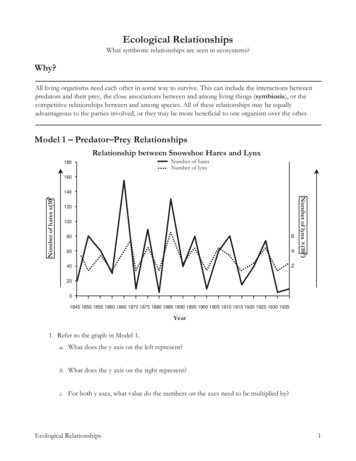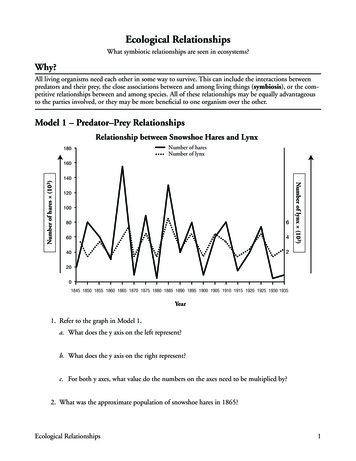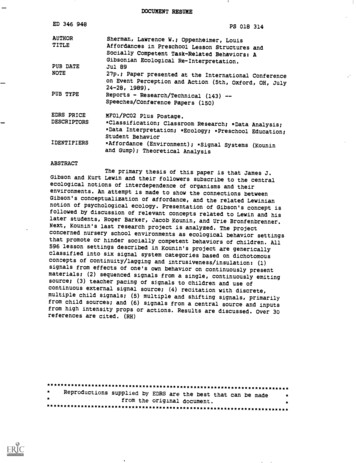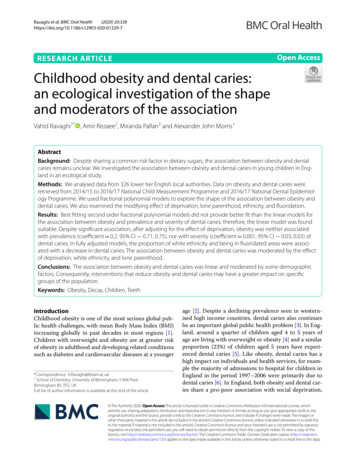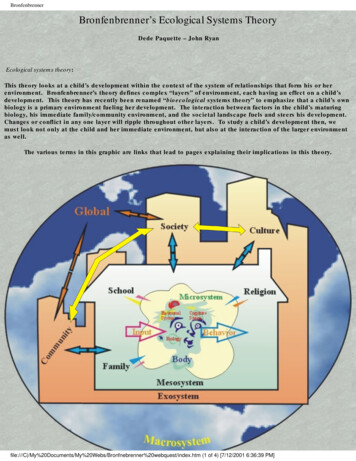
Transcription
BronfenbrennerBronfenbrenner’s Ecological Systems TheoryDede Paquette – John RyanEcological systems theory:This theory looks at a child’s development within the context of the system of relationships that form his or herenvironment. Bronfenbrenner’s theory defines complex “layers” of environment, each having an effect on a child’sdevelopment. This theory has recently been renamed “bioecological systems theory” to emphasize that a child’s ownbiology is a primary environment fueling her development. The interaction between factors in the child’s maturingbiology, his immediate family/community environment, and the societal landscape fuels and steers his development.Changes or conflict in any one layer will ripple throughout other layers. To study a child’s development then, wemust look not only at the child and her immediate environment, but also at the interaction of the larger environmentas well.The various terms in this graphic are links that lead to pages explaining their implications in this theory.file:///C t/index.htm (1 of 4) [7/12/2001 6:36:39 PM]
BronfenbrennerBronfenbrenner’s structure of environment:The microsystem – this is the layer closest to the child and contains the structures with which the child has directcontact. The microsystem encompasses the relationships and interactions a child has with her immediatesurroundings (Berk, 2000). Structures in the microsystem include family, school, neighborhood, or childcareenvironments. At this level, relationships have impact in two directions - both away from the child and toward thechild. For example, a child’s parents may affect his beliefs and behavior; however, the child also affects the behaviorand beliefs of the parent. Bronfenbrenner calls these bi-directional influences, and he shows how they occur among alllevels of environment. The interaction of structures within a layer and interactions of structures between layers is keyto this theory. At the microsystem level, bi-directional influences are strongest and have the greatest impact on thechild. However, interactions at outer levels can still impact the inner structures.The mesosystem – this layer provides the connection between the structures of the child’s microsystem (Berk, 2000).Examples: the connection between the child’s teacher and his parents, between his church and his neighborhood,etc.The exosystem – this layer defines the larger social system in which the child does not function directly. Thestructures in this layer impact the child’s development by interacting with some structure in her microsystem (Berk,2000). Parent workplace schedules or community-based family resources are examples. The child may not bedirectly involved at this level, but he does feel the positive or negative force involved with the interaction with hisown system.The macrosystem – this layer may be considered the outermost layer in the child’s environment. While not being aspecific framework, this layer is comprised of cultural values, customs, and laws (Berk, 2000). The effects of largerprinciples defined by the macrosystem have a cascading influence throughout the interactions of all other layers. Forexample, if it is the belief of the culture that parents should be solely responsible for raising their children, thatculture is less likely to provide resources to help parents. This, in turn, affects the structures in which the parentsfunction. The parents’ ability or inability to carry out that responsibility toward their child within the context of thechild’s microsystem is likewise affected.The chronosystem – this system encompasses the dimension of time as it relates to a child’s environments. Elementswithin this system can be either external, such as the timing of a parent’s death, or internal, such as the physiologicalchanges that occur with the aging of a child. As children get older, they may react differently to environmentalchanges and may be more able to determine more how that change will influence them.Nature vs. Nurture?More modern child development theories accept that both a child’s biology and his environment play a role in changeand growth. Theories now focus on the role played by each and the extent to which they interact in ongoingfile:///C t/index.htm (2 of 4) [7/12/2001 6:36:39 PM]
Bronfenbrennerdevelopment. Bronfenbrenner’s ecological systems theory focuses on the quality and context of the child’senvironment. He states that as a child develops, the interaction within these environments becomes more complex.This complexity can arise as the child’s physical and cognitive structures grow and mature. So, given that naturecontinues on a given path, how does the world that surrounds the child help or hinder continued development? Thisis the question answered by Bronfenbrenner’s theory.Urie Bronfenbrenner, co-founder of Head Start, uses his bioecological model to provide a startlingly clear view of theproblems we have been seeing in our students and in our families. He says that technology has changed our society,and while we are taking great pains to safeguard the physical environment from the damage done by a technology, wehave spent no resources to provide similar safeguards to the damage done to our societal environment. (Henderson,1995). Our economy has shifted from an industrial model to a technological model, yet the patterns of the workplacehave continued to rely on the factory work ethic. Parents are expected to work a schedule that revolves around thefactory whistle – even though they may work in a high tech office. The technology that enables workers to be free ofmanual labor, should also free them from the time and place boundary. Yet, our work ethic demands more face time– not less. As women entered the work force, they too were subject to the same demands. Family life in this countryhas taken a back seat to the needs of the workplace.Also of concern to Bronfenbrenner is the “deficit” model used to determine the level of support granted by the publicto struggling families. Parents must declare themselves deficient in some way in order to qualify for help in solvingproblems that may come about because of our cultural value of independence. A larger degree of failure means alarger amount of support. By working from this deficit model, we expect families to hold their hands up from deepinside a black hole of helplessness. Then, we expect them to have the psychological strength to climb up the thinrope the throw down.Implications for practiceBronfenbrenner sees the instability and unpredictability of family life we’ve let our economy create as the mostdestructive force to a child’s development (Addison, 1992). Children do not have the constant mutual interactionwith important adults that is necessary for development. According to the ecological theory, if the relationships inthe immediate microsystem break down, the child will not have the tools to explore other parts of his environment.Children looking for the affirmations that should be present in the child/parent (or child/other important adult)relationship look for attention in inappropriate places. These deficiencies show themselves especially in adolescenceas anti-social behavior, lack of self-discipline, and inability to provide self-direction (Addison, 1992).This theory has dire implications for the practice of teaching. Knowing about the breakdown occurring withinchildren’s homes, is it possible for our educational system to make up for these deficiencies? It seems now that it isnecessary for schools and teachers to provide stable, long-term relationships. Yet, Bronfenbrenner believes that theprimary relationship needs to be with someone who can provide a sense of caring that is meant to last a lifetime.This relationship must be fostered by a person or people within the immediate sphere of the child’s influence.Schools and teachers fulfill an important secondary role, but cannot provide the complexity of interaction that can beprovided by primary adults. For the educational community to attempt a primary role is to help our society continueits denial of the real issue. The problems students and families face are caused by the conflict between theworkplace and family life – not between families and schools. Schools and teachers should work to support theprimary relationship and to create an environment that welcomes and nurtures families. We can do this while wework to realize Bronfenbrenner’s ideal of the creation of public policy that eases the work/family conflict (Henderson,1995). It is in the best interest of our entire society to lobby for political and economic policies that support theimportance of parent’s roles in their children’s development. Bronfenbrenner would also agree that we should fostersocietal attitudes that value work done on behalf of children at all levels: parents, teachers, extended family,mentors, work supervisors, legislators.file:///C t/index.htm (3 of 4) [7/12/2001 6:36:39 PM]
BronfenbrennerReferencesAddison, J. T. (1992). Urie Bronfenbrenner. Human Ecology, 20(2), 16-20.Berk, L.E. (2000). Child Development (5th ed.). Boston: Allyn and Bacon. 23-38Bronfenbrenner, U. (1990). Discovering what families do. In Rebuilding the Nest: A New Commitment to theAmerican Family. Family Service America [web site]. http://www.montana.edu/www4h/process.html Henderson, Z. P. (1995). Renewing our social fabric. Human Ecology, 23(1), 16-19.Made with MS FrontPage by Dede Paquette and John Ryan for National-Louis Universityfile:///C t/index.htm (4 of 4) [7/12/2001 6:36:39 PM]
The BodyThe Body“Anatomy is destiny”Sigmund Freud, Collected Writings (1924) vol. 5In the bioecological systems approach of Bronfenbrenner, the body is part of themicrosystem. Its effects on the other parts of the microsystem are probably obvious tomost of us. The body is the life support system, the mobility system, and that withwhich we perceive and interact with the environment.There are several characteristics of the body that can influence development indifferent ways. The first and broadest is the general health of the body. A person’shealth is determined by how effectively the various subsystems in the body functionand the influences of environmental factors. The complexity of the human body is wellbeyond the discussion here; from genes to biochemical reactions on the cellular level,from enzymes to proteins, and from bones to skin, we are an amazing collection ofcompounds and structures. If all our systems are working together and effectively, wecan say we are in good health. Unfortunately this is a rather rare situation.There are many more disorders of the body than there are of the mind, and some affectboth. During the course of growth from infant to adult our bodies are assaulted bycountless external threats. We are attacked by almost everything we come in contactwith in one way or another. Airborne pathogens are drawn into our lungs, sunlightbreaks down our skin cells and causes melanoma, and the thorn of a rose pierces ourskin and leaves bacteria inside.Some of us have genetic disorders that cause malfunctions in our internal systems likecystic fibrosis, Tay-Sachs disease, and osteogenesis imperfecta. Or we developconditions as a result of lifestyle or environment like mesothelioma from asbestosexposure, alcoholism, or obesity.Since the body is our life support system, it only makes sense that we try to protect itfrom harm and keep it in good working order despite the innumerable threats we haveto counteract. Modern medical science continues to seek better ways to help us in thisbattle, but there are some basic things we all need to do in order to keep our bodies inthe healthiest condition we can. In the broadest categories of health maintenance are;nutrition, exercise, and prevention.file:///C t/body.htm (1 of 2) [7/12/2001 6:36:55 PM]
The BodyGood nutrition provides the body with the fuel it needs to feed the living cells in allour subsystems, replace damaged cells, and grow new cells. The proper combinationsof vitamins, proteins, enzymes, minerals, and other substances are needed on acontinuing basis to keep the body healthy. Lack of needed components causes avariety of disorders as does over supply.Exercise is necessary to maintain full use of the heart and lungs as well as assistingthe structural components of the body in maintaining their strength and flexibility.Again, as with nutrition, there can be too much of a good thing, resulting in physicaldamage such as broken bones or torn ligaments. We need to know our limits and avoiddangerous situations.Avoidance is one of the ways we prevent damaging ourselves. We learn at some pointin our development that we cannot fly, and so we avoid jumping off buildings. Otherforms of prevention we practice are inoculations against diseases, periodic medicalexams, and the use of safety devices like seatbelts. All of these are designed to keepour bodies from harm.The educational impact of all this involves the ability of our body to aid us in our questfor knowledge. Every one of the above dangers, disorders, or diseases can have animpact on the development of the child and that child’s ability to learn. Poor nutritioncan contribute to learning problems, so can a broken leg. Other physiologicalconditions, quite normal ones, can also have an impact on learning. Hormone changesin adolescence are notorious for causing disruptions in the learning process. In short,anything that happens to the body affects the mind and it’s ability to process data.[ Home ] [ The Behavioral System ] [ The Body ] [ Brain ] [ The Cognitive System ] [ Culture ][ Emotional System ] [ FAMILY ] [ Global Influences in the Macrosystem ] [ Religion or Spirituality ][ Schools ] [ Society ]Made with MS FrontPage by Dede Paquette and John Ryan for National-Louis Universityfile:///C t/body.htm (2 of 2) [7/12/2001 6:36:55 PM]
BrainBrain & Biology“I am a Bear of Very Little Brain, and long words Bother me.”Winnie-the-Pooh, A.A. Milne (1926)The biology of the brain is certainly one of the most important systems in a developingchild. The health of the child’s brain will have a great impact on the rate and quality ofdevelopment in all areas. Since all senses and motor functions are centralized here,virtually any activity must begin with the brain. Damage due to disease or injury canimpair activity and cause a variety of developmental difficulties. There are numerouscauses for brain injury, and they can strike at any time in the developmental processup to and including adulthood. In addition to trauma, disease is a major contributor tobrain injuries. Millions of dollars are spent annually on research to find a way to stopthe progression of Alzheimer’s disease, a pathology nearly exclusive to the elderly.Other diseases affect all age groups. Encephalitis, meningitis, Creutzfeldt-Jakob, andothers are caused by external pathogens that can be acquired by any individualthrough the process of a normal life. The causes of many other conditions that affectthe brain are genetic. Parkinson’s, Huntington’s, and Down’s are just a few of the morethan 1000 genetic based brain disorders that have been identified. Other causes areenvironmental or are related to prenatal care issues such as fetal alcohol syndrome, amajor cause of mental retardation. A fairly comprehensive source of information onneurological matters is the National Institute of Health o.html.In addition to the physiological causes of brain related issues, there are psychologicaland pharmacological factors that can affect a developing child in many ways.Depression and substance abuse are two of the largest problems faced by adolescents;both can have serious affects on learning and behavior. According to NIH statistics, inthe United States alone, 9 million children and adolescents have some form of mental,behavioral, or emotional disorder and only 1/3 are receiving any treatment.file:///C t/brain.htm (1 of 2) [7/12/2001 6:37:42 PM]
Brain[ Home ] [ The Behavioral System ] [ The Body ] [ Brain ] [ The Cognitive System ] [ Culture ][ Emotional System ] [ FAMILY ] [ Global Influences in the Macrosystem ] [ Religion or Spirituality ][ Schools ] [ Society ]Made with MS FrontPage by Dede Paquette and John Ryan for National-Louis Universityfile:///C t/brain.htm (2 of 2) [7/12/2001 6:37:42 PM]
Brain Awareness Week: What is Neuroscience?These statistics are taken from updates from Public Information departments at the National Institutes ofHeath and Research!America. For more information, please visit the NIH Web site, http://www.nih.gov/ orcontact Research!America at 703-739-2372.What is Neuroscience?Neuroscience is the study of the brain and nervous system.Each day, neuroscientists are unraveling the mysteries of thehuman brain, answering questions such as: What is the mind?Why do we feel emotions? How do we learn, remember, andprocess information? What are the underlying causes ofneurological and psychiatric disorders?Neuroscientists investigate the molecular and cellular levels ofthe nervous system; the systems within the brain, such as visionand hearing; and behavior produced by the brain. This researchprovides the basis for understanding the medical fieldsconcerned with treating nervous system disorders. These medical specialties include neurology,neurosurgery, psychiatry and ophthalmology.Neuroscientists have made enormous strides in understanding our most mystifying organ and treatingdisorders of the brain and nervous system that affect an estimated 50 million Americans each year. Stroke,spinal cord injury, chronic pain, learning disabilities, depression - these are but a few of the areas beingaddressed by neuroscientists.Neuroscience research priorities include the following: Basic research in neurochemistry, neurogenetics, neuropathology, and other fundamentalneurosciences, to identify the secrets of the brain and nervous system that will open the door to newclinical opportunities.Applied research to understand the brain's control of behavior, mood and innate creativity, and clinicaltrials to develop and bring to the market effective therapeutics for the treatment of neurologicaldiseases, including research on the availability, access, use, and costs of mental health care and furtherdevelopment of promising model programs and s.neuro.html (1 of 8) [7/12/2001 6:37:54 PM]
Brain Awareness Week: What is Neuroscience? Research efforts in the genetic basis of neurological disorders to address the increasing evidence ofthe genetic basis for many diseases.Mechanisms of repair to identify how the brain restores itself after being damaged and to furtherexplore the fundamental neurobiology of the normal nervous system.Training of research scientists and clinicians in the field of neuroscience, to develop the basis fortomorrow's research.Statistics Regarding Neurological Diseases And Disorders 50 million Americans have a permanent, neurological disability that limits their daily activities.1 in 3 Americans will experience some form of mental disorder at some point in their lives, and morepeople are hospitalized with neuropsychiatric disorders than any other disease.18 million Americans suffer from depression. Disability from depression exceeds that of diabetes,hypertension, gastrointestinal, and lung diseases, and costs 43.7 billion annually.More than 1 in 20 Americans have developmental disorders of the nervous system, such as cerebralpalsy, spina bifida, mental retardation, and learning disorders. Health care associated with thesedisorders costs 30 billion annually.9 million children and adolescents in the U.S. are affected by a mental, behavioral, or developmentaldisorder; only one third of them get treatment.4 million older Americans suffer from Alzheimer's Disease at a cost of 100 billion each year,primarily from nursing home and other costs of long term care.3 million incidences of stroke are reported each year at a cost of 30 billion. 1,200 Americans are newstroke victims every day; 1/3 of these die and 1/3 are permanently disabled.3 million Americans are affected by panic disorders during their lifetimes. The suicide rate for theseindividuals is 20 times that of the general population.2 million Americans suffer from schizophrenia, the most chronic and disabling of mental illnesses.The cost for treatment is 32.5 billion annually. Approximately 300,000 new cases are diagnosedevery year.1 million Americans suffer from genetic disorders resulting in brain and nerve damage. More than1000 of these genetic disorders have been identified, many of which result in disability or death.1 million cases of traumatic head injury are reported each year, resulting in 100,000 deaths and ro.html (2 of 8) [7/12/2001 6:37:54 PM]
Brain Awareness Week: What is Neuroscience?costs of 25 billion. 500,000 Americans suffer from Parkinson's Disease incurring health costs of 6 billion annually. 250,000 cases of traumatic spinal cord injury are reported each year at a cost of 10 billion annually. 40,000 Americans are stricken with brain tumors each year, resulting in paralysis or death. 25,000 Americans are afflicted with Huntington's Disease and another 125,000 are at risk. 2 million people suffer from nerve and muscle disorders, such as Lou Gehrig's Disease and nervedamage associated with diabetes.Each year, addiction to tobacco and illicit drugs kills more than 400,000 people. An understanding ofthe underlying neurobiological causes of addiction is leading to more effective treatments.14 million adult Americans meet the diagnostic criteria for alcohol abuse and alcoholism. Costsassociated with these disorders are 98.6 billion annually.Fetal alcohol syndrome (FAS) is the leading known preventable cause of mental retardation. FAScosts are estimated at 2 billion per year in the United States.The retina of the eye is also part of the brain; for researchers, it is the most accessible part of the brain.Retinal tissue is full of nerve cells essential for vision.By the year 2030, an estimated 6.3 million Americans will have some form of macular degeneration, adisease that destroys the center of the retina and has no effective treatment in most cases. Blindness orvision loss are the result.More than 100,000 Americans have retinitis pigmentosa, a disease that destroys specific nerve cells inthe retina. Most people with retinitis pigmentosa are blind by the age of 40.Economic Burden of Brain Diseases and Disorders Brain-related diseases and injuries are estimated to exceed over half a trillion dollars a year in healthcare, lost productivity and other economic costs.Brain-related disorders account for the majority of our nation's long term care costs, and , whencombined with psychiatric disorders, account for more hospitalization and prolonged care than almostall other diseases combined.Federal disability payments attributed to severe mental illnesses amount to 14 billion annually, 25percent of total neuro.html (3 of 8) [7/12/2001 6:37:54 PM]
Brain Awareness Week: What is Neuroscience? Eye diseases and vision disorders are costly. Each year, society pays 38.4 billion in direct andindirect costs.Potential Savings From Brain Research A five year delay in the onset of Alzheimer's Disease could cut health care spending by as much as 50 billion annually.A five year delay in the onset of stroke could save 15 billion annually.A five year delay in the onset of Parkinson's Disease could save as much as 3 billion each year inhealth care costs.Economic Benefits Of Biomedical Research NIH research helps support skilled jobs both in NIH-supported laboratories and in the many UScompanies that provide materials and instruments used in research.Successes in the biotechnology and pharmaceutical industries are directly related to NIH support ofclinical and especially laboratory research. In 1994, the 1,311 US biotechnology firms employed103,000 people and generated 11.2 billion in revenues.The top 15 US pharmaceutical industries employ more than 350,000 people and earn profits of 13.3billion on sales of 84.8 billion.Recent Discoveries/Opportunities in Brain Research Gene therapy may lead to treatment for Alzheimer's - Based on a study involving primates,scientists may soon be able to employ genetic engineering to treat such devastating human diseases asAlzheimer's and Parkinson's disease. Studies reveal that a substance called human nerve growthfactor, a naturally occurring protein, has beneficial effects on brain cells. When genetically engineeredgrowth factor-producing cells were injected into the brains of monkeys, deterioration was reversed inup to 92 percent of diseased brain cells.Nerve cell grafts may repair spinal cord injury - NIH-funded scientists recently discovered a groupof proteins named netrins that act as long-range guidance signals for sprouting nerve cells duringdevelopment. Information about how netrins work to guide new nerve cell projections may lead tml (4 of 8) [7/12/2001 6:37:54 PM]
Brain Awareness Week: What is Neuroscience?treatments for regenerating nerves after injury and refined methods of nerve grafting andtransplantation. Parkinson's advance - Studies of a procedure called pallidotomy, which destroys overactive neuronsin a brain region called the globus pallidus, show that many patients improve significantly followingtreatment. One new study shows a marked reduction in rigidity and paralysis, improved motorresponses to Parkinson's drugs, and disappearance of uncontrolled movements following pallidotomy.The procedure is now being tested in an NIH sponsored clinical study that should determine whichpatients are best suited for surgery and how long the benefits of pallidotomy will last.Protein yields clues to Huntington's disease - New studies reveal a protein that binds to abnormalmolecules and may lead to the first effective treatment for Huntington's disease. HAP-1 is the firstmolecule shown to bind to huntingtin, the protein that is damaged in Huntington's disease. Whilehuntingtin is found in many regions of the body, HAP-1 is found only in brain cells affected by thedisease. This suggest that it causes the brain damage seen in Huntington's disease and that agents thatblock it from working may be able to prevent this disorder.Emergency treatment for stroke - Extensive NIH-supported laboratory research on the mechanismof blood clotting contributed to the development of clot-dissolving drugs such as t-PA. This researchand its applications already have important implications for stroke. With the brain starved of oxygenand other nutrients, damage follows quickly and often with devastating effect. Researchers now haveshown that the clot-dissolving drug t-PA is an effective emergency treatment for strokes when givenwithin 3 hours of initial symptoms.Genes protect against stroke damage - Researchers have also identified several genes that protectnerve cells against death when they are exposed to stress caused by factors such as stroke. Scientistshope to find ways to manipulate these genes to improve nerve cell survival in stroke and degenerativeneurological diseases.Synaptic proteins yield clues into muscular dystrophy - Scientists studying how synapses formbetween nerve and muscle cells have identified a protein called agrin that is secreted by nerve cellsand causes clustering of important molecules in the muscle cell. Receptors, or protein docking sites,for agrin are closely related to a molecule called dystroglycan that is linked to several forms ofmuscular dystrophy. Understanding how agrin and dystroglycan work could help scientists understandwhy muscle cells die in muscular dystrophy and lead to new treatments for the disease.Altered breathing linked to "crib death" - Researchers have found clues to the early signs ofsudden infant death syndrome (SIDS), which may lead to ways of screening infants for risk of SIDS.In these babies, many show altered breathing patterns as early as the first week of life.Deciphering the schizophrenic brain - Using a brain imaging technique called positron emissiontomography, or PET, scientists have shown that patients with schizophrenia use as much of their brainto perform a very simple sound discrimination task as normal people do when performing ademanding task. The abnormal mental strategies could result from factors such as abnormal brainwiring. Understanding why they occur will lead to an improved understanding of the euro.html (5 of 8) [7/12/2001 6:37:54 PM]
Brain Awareness Week: What is Neuroscience? Genetic error linked to mental retardation - Recent studies reveal that mutations, or errors, in agene called L1 cause severe malformations in human brain development that can lead to mentalretardation and other abnormalities. Studies of L1's function in the brain may reveal ways ofmimicking its protein product in a way that will help individuals suffering from these syndromes.Other research has shown that alcohol, even at moderate amounts, impairs the function of the L1protein. This mechanism may explain the sever mental impairment seen in fetal alcohol syndrome andother alcohol-related birth defects.The brain and blood pressure - Recent studies show that three of eight tiny brain organs ca
Nov 10, 2009 · beyond the discussion here; from genes to biochemical reactions on the cellular level, from enzymes to proteins, and from bones to skin, we are an amazing collection of compounds and structures. If all our systems are working together and effectively, we can say we are in go


